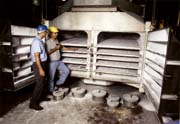
In early 2000, Flock was developing plans for the installation of new sugar screeners in the Toronto facility when space – the amount he had and the amount he didn’t – became an issue. “The space I had to work with is between four pillars and measures about 15-ft. square. The severe space limitation quickly eliminated a number of conventional screeners that might have been considered for the new installation because their footprint was simply too large,” says Flock.
Sugar screeners play a critical role near the end of sugar processing. After white granulated sugar crystals have been dried, various size crystals are still present. Since Redpath’s sugar is sold in specific ranges of crystal size, the mixture must be sorted to obtain granular sizes that correspond to its products. Despite the refinery’s size, finding room in the buildings to expand and install new processing equipment to meet higher production needs was a challenge.
Based on Redpath’s previous experience with Rotex, Flock selected the Rotex Megatex M100 series screener. With 120-sq. ft. of screening area, the M100 reduced capital outlay as well as installation, operation and floor space costs. “The 10-ft. x 10-ft. x 12-ft. footprint of the Megatex fit perfectly in the space available. It also met all our volume requirements,” says Flock.
The Megatex’s design offers wide screens and long-stroke, gyratory motion to increase productivity. It evenly splits and distributes the incoming flow of sugar to stacked 4-ft. x 8-ft. screen decks—the equivalent of a bank of four screeners in a single machine. Using screen surfaces that are wider, rather than longer, reduces bed depth.
To further achieve a wide screening area, Megatex uses a two-bank, multi-level screen deck arrangement to present 16-ft. to 50-ft. of width to the feed, which keeps bed depth low and maintains screen accuracy and efficiency at high capacities. The screener also uses a long stroke and low frequency motion to produce ball mesh cleaning to control screen blinding and provide uninterrupted operation.
Flock has been impressed with the equipment’s performance, so much so that the company plans to allocate space for two more M100 series screeners. “We’re very pleased with the results,” says Flock. “The Megatex is exceptionally efficient.”
For more information:
Rob Scheper, 800-453-2321
info@rotex.com.